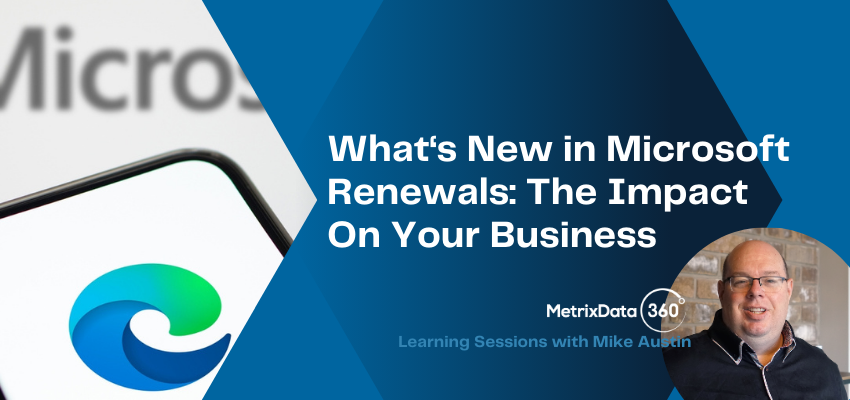If you missed our recent learning session where Mike Austin shared insights on managing Microsoft EA renewals, you can still watch it here on demand. In this article, we provide highlights from this session to help you implement proven strategies for managing Microsoft contract renewals, reducing costs, and ensuring compliance.
Navigating Microsoft’s Complex Licensing and Cost Management
Microsoft’s licensing structures are inherently complex, encompassing numerous programs, license types, and bundles. A lack of transparency in pricing models compounds this complexity. For example, distinguishing between the Enterprise Agreement (EA) and the Cloud Solution Provider (CSP) program is not always straightforward, which can hinder informed decision-making. Adding to this, Microsoft’s recent strategy to transition smaller organizations into the CSP program introduces additional challenges. This shift aligns with Microsoft’s efforts to manage rising costs and renewals, illustrated by the upcoming 10% price increase for Windows Server in 2025.
To navigate these challenges, organizations must adopt a proactive and strategic approach to managing Microsoft renewals. Key steps include initiating renewal discussions at least 12 months in advance and maintaining active oversight of agreements throughout the contract lifecycle.
Mapping actual usage data is vital to uncover savings opportunities. For instance, analyzing Microsoft 365 E5 licenses often reveals that many users do not require the full suite of features. By downgrading to more suitable license types, organizations can realize significant cost savings. One of our clients, a large utility company, achieved an annual savings of $1.2 million by transitioning non-essential users to lower-tier licenses.
Alternatives to Microsoft’s Upsell Tactics
Organizations should critically evaluate Microsoft’s upsell strategies and explore cost-effective alternatives. This may include transitioning from E5 to E3 licenses or reverting from Microsoft 365 to Office 365, depending on specific requirements. Conducting a detailed evaluation of your security stack and considering competitive products can also yield substantial savings.
Developing a negotiation roadmap at least nine months before renewal is crucial. This roadmap should identify potential cost levers, such as Azure credits, support discounts, or license downgrades. For example, negotiating Azure agreements with tiered spending commitments can unlock incremental discounts, leading to meaningful cost reductions.
Adapting to Microsoft’s Reseller Model Changes
Microsoft’s recent changes to its reseller model have shifted more responsibilities to customers. By transitioning their top 20% of customers to a direct model and reducing Licensing Solution Providers (LSPs) fees, organizations now face tasks traditionally managed by LSPs, such as reporting and purchasing. Understanding the differences between LSPs and CSPs and the services they offer is critical to making informed decisions and ensuring all necessary support structures are in place.
Aligning with Microsoft’s Strategic Priorities
To optimize costs, organizations should align their strategies with Microsoft’s current product priorities. Products like Copilot, Power Platform, and Microsoft 365 E5/E3 are strategic focus areas for Microsoft, often accompanied by discounts and incentives. Conversely, securing discounts on products like Windows and SQL Servers is increasingly difficult unless the deals are substantial. Aligning your organizational needs with Microsoft’s goals can improve your negotiation position.
Moving Beyond Unit Price Negotiations
Relying solely on unit price negotiations is no longer effective. As Microsoft reduces discounting flexibility and raises prices, alternative cost-saving measures must be prioritized. Key strategies include optimizing license assignments, implementing archival practices, and eliminating unused licenses. For instance, regularly auditing licenses can prevent costs associated with blocked accounts or inactive users.
Communication and Planning: Keys to Success
Open and early communication with Microsoft is critical. Engaging in frequent discussions about your organizational needs ensures better alignment with Microsoft’s strategic goals and minimizes surprises. Building strong business cases and conducting pilots for new solutions, like Power Apps, can secure internal buy-in and ensure smooth implementation.
Proper planning and monitoring are essential to avoid pitfalls, such as poor adoption. One client struggled to transition from Zoom to Teams due to inadequate training and user engagement, leading to missed opportunities for savings and efficiency.
The Path to Optimized Renewals
To effectively manage Microsoft renewals, organizations need a comprehensive, proactive strategy that includes:
- Understanding Microsoft’s licensing structures.
- Initiating renewal discussions early (12+ months in advance).
- Mapping actual usage data to uncover savings.
- Exploring alternatives to Microsoft’s upsell tactics.
- Building a robust negotiation roadmap.
Leveraging tools like SLIM 360 (MetrixData 360’s Microsoft license and cost optimization platform) can further optimize license usage by identifying opportunities for reclamation and cost savings. By implementing these strategies, your organization can reduce costs, ensure compliance, and confidently navigate the complexities of software asset management.







